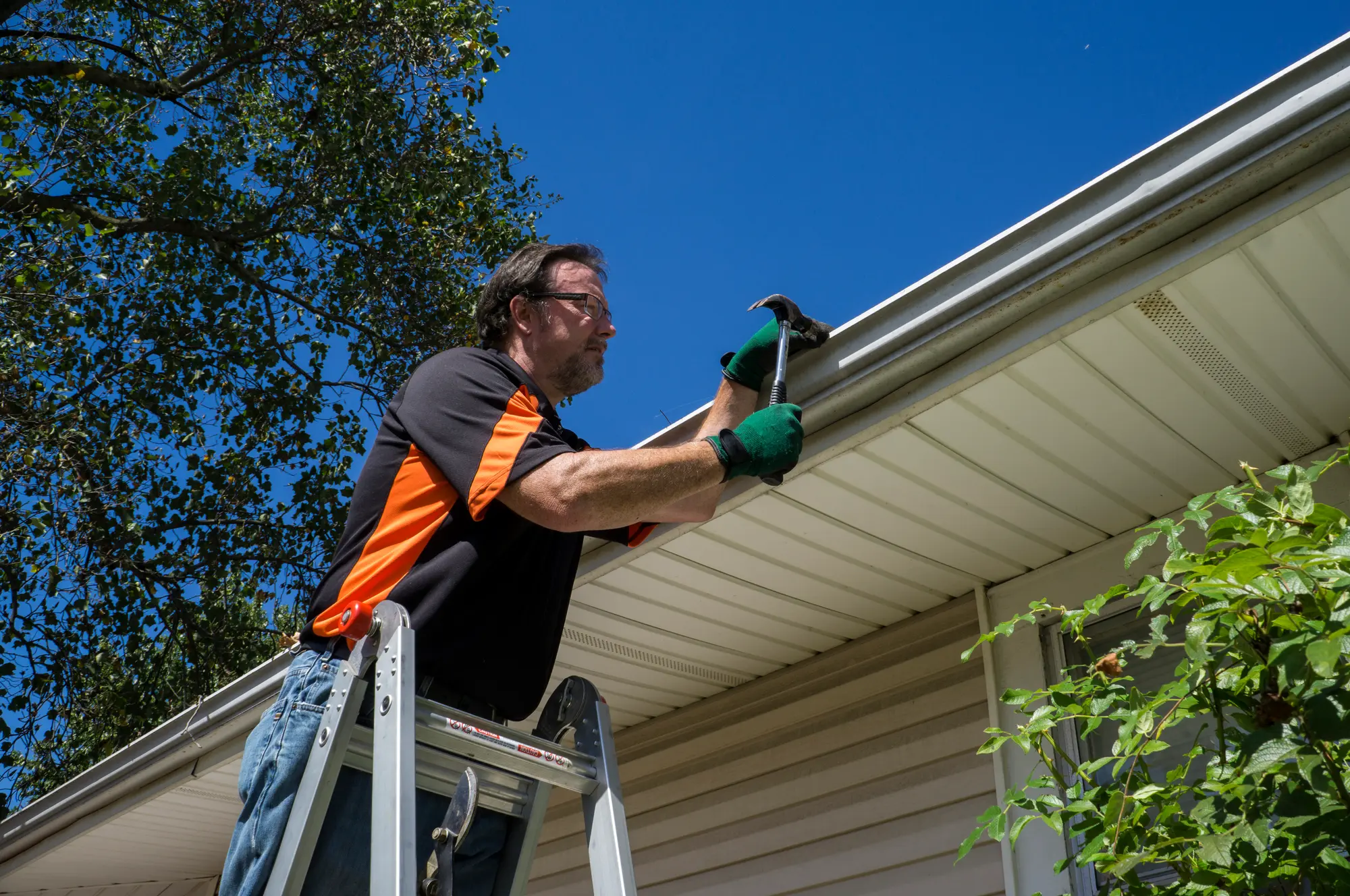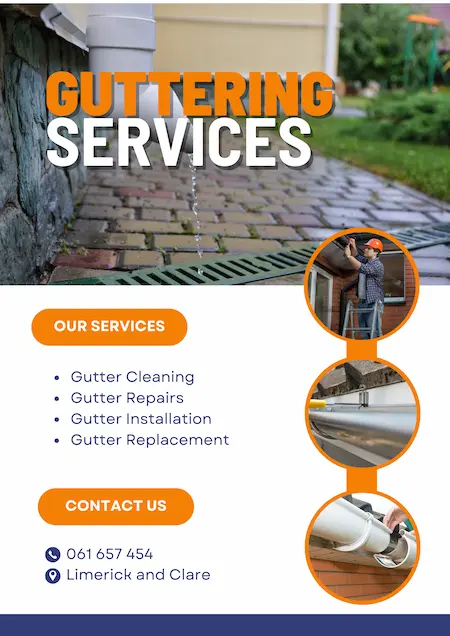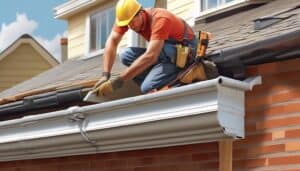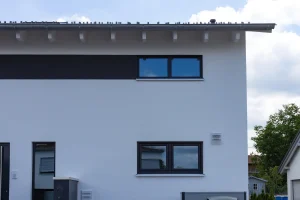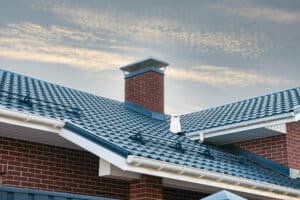Maintaining the functionality and integrity of your home gutters is crucial for protecting your property from water damage. Whether it’s due to wear and tear, clogs, or minor damages, repairing home gutters promptly is essential.
In this blog post, we will provide you with valuable tips and techniques to effectively address common gutter issues and ensure your gutters are in optimal condition. With our handy tips for repairing home gutters, you can protect your home and prevent costly repairs down the line.
Key Takeaways
- Wear safety gear and take precautions when working on gutters.
- Regularly assess and clean gutters to prevent clogs and leaks.
- Seal any leaks or holes in the gutter system to avoid water damage.
- Properly align and replace damaged gutters to ensure proper drainage.
Safety Precautions First
Before you tackle any repairs, ensure you’ve got the right safety gear to prevent accidents. Remember, when you’re fixing home gutters, you’re up against more than just water damage. You’re often high up on a ladder, so safety precautions first, alright? Wear a sturdy helmet, gloves, and non-slip boots, because a solid grip can make all the difference between a job well done and a trip to the ER.
Practice ladder safety by making sure your ladder is in good condition and properly positioned. It should be on stable, level ground and extend at least three feet over the gutter line for safe access. Don’t lean too far out; keep your waist within the ladder rails. After all, no repair is worth risking your well-being.
Assessing Gutter Damage
Once you’re geared up for safety, it’s time to examine the gutters for any signs of damage such as cracks, holes, or separations. Start by checking the entire length of the guttering for visible issues. Look out for areas where water might be leaking or overflowing—this usually indicates a blockage.
You’ll want to remove any debris that would otherwise accumulate over time. Remember: these are often the culprits behind clogged gutters.
After clearing out the debris, pour water down the gutters to check for proper flow. If water pools or spills over the sides instead of flowing freely, there’s likely an obstruction or slope issue. Inspect the downspouts too, as clogs here can cause water to back up and damage your gutters.
Cleaning Gutters Effectively
Moving on from assessing damage, you’ll need to thoroughly clean your gutters to ensure they’re free of obstructions. Begin by removing leaves and debris by hand or with gutter cleaning tools, wearing gloves for protection. Next, flush the gutters with a hose to clear out smaller particles; this will also help you spot any leaky gutters. If you’re dealing with stubborn clogs, a plumber’s snake can be an effective tool to dislodge them.
To make cleaning gutters effectively a less frequent chore, consider investing in gutter guards. These devices can prevent large debris from entering the gutters, reducing the likelihood of clogs and minimizing the maintenance required.
Sealing Leaks and Holes
After you’ve cleaned your gutters, it’s time to tackle any leaks or holes you’ve uncovered by applying a gutter sealant or patch to ensure they’re watertight.
- Start by ensuring the area you are sealing is completely dry as moisture can prevent the sealant from adhering properly.
- Apply a generous amount of sealant over the hole or crack, smoothing it out to create an even surface.
- For larger holes, you might need to use a patch. Cut a piece of metal flashing to size and affix it over the damaged area with sealant.
- Press firmly and apply more sealant around the edges.
- Pay special attention to the joints, especially where the gutters meet the downspout.
Realigning Sagging Gutters
While you’ve ensured your rain gutters are leak-free with sealant, you’ll also need to address any sagging sections that could impede water flow. A sagging gutter can be more than an eyesore; it can lead to serious water damage if not fixed promptly.
Here’s what you should do:
- Inspect the Gutters: Look for any obvious signs of bending or detachment away from the fascia.
- Tighten or Replace Brackets: Secure any loose brackets and replace those that are damaged or rusted.
- Ensure Proper Slope: Gutters should have a slight slope towards the downspouts for optimal water drainage.
- Check gutter bolts: In some cases, sagging gutters may require the use of gutter bolts. These specialised fasteners can help reinforce the attachment of the gutter to the fascia, providing added support and stability.
Replacing Damaged Sections
How do you tackle sections of your gutters that are beyond repair due to damage or deterioration?
First, you’ll need to assess which parts are damaged. Look for holes, cracks, and any sections that are clearly detached from the roof. Once you’ve identified them, it’s time for some DIY action.
Remove the damaged sections by unscrewing the fasteners or cutting the gutters away with a hacksaw. Make sure you’re wearing gloves to avoid cuts.
Next, measure the gap and cut a new piece of gutter to fit. Secure it in place with gutter seals or screws, ensuring it’s sloped correctly towards the downpipes for proper drainage.
Installing Gutter Guards
Once you’ve replaced damaged sections, consider the longevity of your gutters by installing gutter guards to help you avoid gutter clogs. Gutter guards are designed to fit over the gutter rather than replace it, providing an additional layer of protection against debris accumulation.
These guards can be a do-it-yourself project that doesn’t require an array of specialised tools.
Here’s a quick guide on installing them:
- Measure your gutters: Before purchasing, ensure you know the length and type of your gutters to get the right fit.
- Choose the right guards: There are various materials and styles. Select one that suits your climate and gutter type.
- Install with care: Follow the manufacturer’s instructions. Typically, you’ll need to slide the guards under the roof shingles and snap them onto the gutter edge.
With gutter guards in place, you’ll spend less time on maintenance and more time enjoying your home.
Installing an Additional Downspout for Improved Drainage
If you find that your gutters are overflowing or not effectively directing water away from your home, installing an additional downspout can help improve drainage and prevent water damage. A single downspout may not always be sufficient, especially if you have a large roof surface or areas prone to heavy rainfall.
Adding an extra downspout can distribute the water load more evenly and reduce the risk of overflowing or backups.
Before proceeding with the installation, ensure you carefully plan the location and consider factors such as the slope of the ground and the proximity to your home’s foundation.
Using Gutter Repair Tape for Quick Fixes
Sometimes, you may encounter small cracks or leaks in your gutters that can be easily fixed without the need for extensive repairs. This is where gutter repair tape can come in handy. Gutter repair tape is a specialised adhesive tape designed to create a watertight seal over minor gutter damage.
Here’s how you can effectively use gutter repair tape:
- Clean the area: Ensure the damaged section of the gutter is clean and dry. Remove any debris or loose particles that may affect the tape’s adhesion.
- Cut the tape: Measure and cut a piece of gutter repair tape slightly longer than the damaged section. This will provide ample coverage and ensure a secure seal.
- Apply the tape: Starting from one end of the damaged area, press the tape firmly onto the gutter, covering the crack or leak completely. Smooth out any wrinkles or air bubbles to ensure a tight seal.
- Repeat if necessary: If the crack or leak extends beyond the length of one piece of tape, cut and apply additional pieces to cover the entire damaged section.
Gutter repair tape is a temporary solution that can provide a quick fix for minor gutter issues. However, it’s important to note that it may not be a long-term solution for significant damage or large leaks. If you have major gutter problems, it’s best to consult a professional handyman for proper gutter repairs.
Preventing Future Issues
Maintaining your gutters regularly will help prevent the buildup of debris and avoid costly repairs down the line. You’ll want to make it a habit to check and clean your gutters at least twice a year—typically in the fall and spring.
Ensure downspouts are directing water away from your home’s foundation, as pooled water can lead to damage.
Consider installing gutter guards if you haven’t already, as they can greatly reduce the amount of debris that gets into your gutters. Additionally, inspect for signs of wear and tear such as rust or cracks. If you spot any issues, address them promptly to prevent further damage.
Lastly, make sure your gutters are securely attached to your home; loose gutters can lead to improper drainage and potential water damage.
Scheduling Regular Maintenance
In light to prevent future issues, you’ll need to set a schedule for regular gutter maintenance to ensure they remain in top condition. Consistent upkeep isn’t just about clearing out leaves and debris; it’s about spotting potential problems before they escalate.
Here’s a straightforward approach to keeping your gutters in check:
- Inspect gutters seasonally: Change of seasons can bring different types of debris and weather damage.
- Clean gutters at least twice a year: Preferably in the spring and fall, to prevent clogs and water damage.
- Check for repairs after severe weather: High winds, heavy rain, or snow can cause unexpected wear or damage.
Calling Professionals for Help
In some cases, repairing home gutters may require specialised skills or equipment that you may not possess.
If you feel uncertain about tackling certain issues or if the repairs seem too challenging, don’t hesitate to seek professional help. Calling experienced gutter repair professionals can ensure that the job is done correctly and efficiently, especially when dealing with complex problems or intricate gutter systems.
Attempting repairs beyond your expertise may lead to costly mistakes or make gutter cleaning more difficult in the long run. Remember, it’s better to be safe and seek professional assistance when needed.
